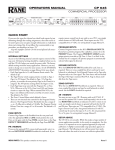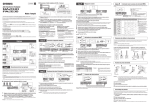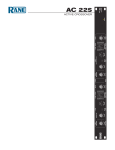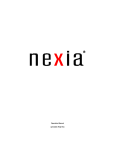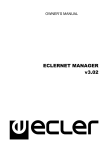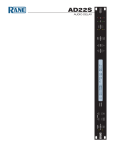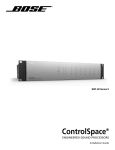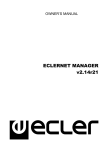Download G4 Manual - Rane Corporation
Transcript
ms 250 dB 0 80 ACTIVE BYPASS DEPTH 20 60 n:1 INT 8 6 ms 500 Hz 315 5k 1.25k NORMAL LISTEN LOW-CUT 20 80 1 20k 6.3k 3 2 MASTER GATE DUCK EXP HIGH-CUT Hz 2k Sec .5 HOLD 200 630 0 .25 12 OL 2 Sec 6 RELEASE 25 125 3 250 OPEN 1 SIDE-CHAIN EXT RATIO 1 2 4 0 100 40 20 25 ATTACK dBu 10 THRESHOLD -60 -50 50 -1 TH SIDE-CHAIN dBr -3 LINK 2 dBu 20 10 dB 40 0 20 ACTIVE BYPASS DEPTH 80 60 THRESHOLD -60 -50 ms 50 250 100 n:1 4 INT 8 6 2 Sec Hz 315 5k 1.25k NORMAL LISTEN 20k 6.3k 3 2 GATE DUCK EXP HIGH-CUT Hz 2k Sec .5 HOLD 200 630 0 .25 12 OL 500 LOW-CUT 20 80 SIDE-CHAIN EXT RATIO 1 2 ms 6 RELEASE 25 3 250 OPEN 1 125 -1 TH SIDE-CHAIN dBr -3 ATTACK 0 25 -24 -12 -6 -30 -20 -10 -40 0 CLOSED SLAVE dBu 20 10 dB 40 0 20 ACTIVE BYPASS DEPTH 80 60 THRESHOLD -60 -50 -30 -20 -10 -40 0 CLOSED ms 50 250 100 n:1 4 INT 8 6 2 Sec Hz 315 5k 1.25k NORMAL LISTEN 3 20k 6.3k 3 2 MASTER GATE DUCK EXP HIGH-CUT Hz 2k Sec .5 HOLD 200 630 0 .25 12 OL 500 LOW-CUT 20 80 SIDE-CHAIN EXT RATIO 1 2 ms 6 RELEASE 25 3 250 OPEN 1 125 -1 TH SIDE-CHAIN dBr -3 ATTACK 0 25 -24 -12 -6 LINK 4 dBu 20 10 dB 40 0 20 ACTIVE BYPASS DEPTH 80 60 THRESHOLD -60 -50 ms 50 250 100 n:1 4 INT 8 6 3 ms 250 500 Hz 315 5k 1.25k NORMAL LISTEN LOW-CUT 20 80 20k 6.3k 3 2 GATE DUCK EXP HIGH-CUT Hz 2k Sec .5 HOLD 200 630 0 .25 12 OL 2 Sec 6 RELEASE 25 SIDE-CHAIN EXT RATIO 1 2 1 OPEN 125 -1 TH SIDE-CHAIN dBr -3 ATTACK 0 25 -24 -12 -6 -30 -20 -10 -40 0 CLOSED SLAVE POWER G4 QUAD GATE GATE -30 -20 -10 -40 0 CLOSED -24 -12 -6 G4 IMPORTANT SAFETY INSTRUCTIONS 1. Read these instructions. 2. Keep these instructions. 3. Heed all warnings. 4. Follow all instructions. 5. Do not use this apparatus near water. 6. Clean only with a dry cloth. 7. Do not block any ventilation openings. Install in accordance with manufacturer’s instructions. 8. Do not install near any heat sources such as radiators, registers, stoves, or other apparatus (including amplifiers) that produce heat. 9. Do not defeat the safety purpose of the polarized or grounding-type plug. A polarized plug has two blades with one wider than the other. A grounding-type plug has two blades and a third grounding prong. The wide blade or third prong is provided for your safety. If the provided plug does not fit into your outlet, consult an electrician for replacement of the obsolete outlet. 10. Protect the power cord and plug from being walked on or pinched particularly at plugs, convenience receptacles, and the point where it exits from the apparatus. 11. Only use attachments and accessories specified by Rane. 12. Use only with the cart, stand, tripod, bracket, or table specified by the manufacturer, or sold with the apparatus. When a cart is used, use caution when moving the cart/apparatus combination to avoid injury from tip-over. 13. Unplug this apparatus during lightning storms or when unused for long periods of time. 14. Refer all servicing to qualified service personnel. Servicing is required when the apparatus has been damaged in any way, such as power supply cord or plug is damaged, liquid has been spilled or objects have fallen into the apparatus, the apparatus has been exposed to rain or moisture, does not operate normally, or has been dropped. 15. The plug on the power cord is the AC mains disconnect device and must remain readily operable. To completely disconnect this apparatus from the AC mains, disconnect the power supply cord plug from the AC receptacle. 16. This apparatus shall be connected to a mains socket outlet with a protective earthing connection. 17. When permanently connected, an all-pole mains switch with a contact separation of at least 3 mm in each pole shall be incorporated in the electrical installation of the building. 18. If rackmounting, provide adequate ventilation. Equipment may be located above or below this apparatus, but some equipment (like large power amplifiers) may cause an unacceptable amount of hum or may generate too much heat and degrade the performance of this apparatus. 19. This apparatus may be installed in an industry standard equipment rack. Use screws through all mounting holes to provide the best support. WARNING: To reduce the risk of fire or electric shock, do not expose this apparatus to rain or moisture. Apparatus shall not be exposed to dripping or splashing and no objects filled with liquids, such as vases, shall be placed on the apparatus. WARNING The symbols shown below are internationally accepted symbols that warn of potential hazards with electrical products. CAUTION RISK OF ELECTRIC SHOCK DO NOT OPEN ATTENTION: RISQUE DE CHOCS ELECTRIQUE - NE PAS OUVRIR To reduce the risk of electrical shock, do not open the unit. No user serviceable parts inside. Refer servicing to qualified service personnel. This symbol indicates that a dangerous voltage constituting a risk of electric shock is present within this unit. This symbol indicates that there are important operating and maintenance instructions in the literature accompanying this unit. WARNING: This product may contain chemicals known to the State of California to cause cancer, or birth defects or other reproductive harm. NOTE: This equipment has been tested and found to comply with the limits for a Class B digital device, pursuant to part 15 of the FCC Rules. These limits are designed to provide reasonable protection against harmful interference in a residential installation. This equipment generates, uses and can radiate radio frequency energy and, if not installed and used in accordance with the instructions, may cause harmful interference to radio communications. However, there is no guarantee that interference will not occur in a particular installation. If this equipment does cause harmful interference to radio or television reception, which can be determined by turning the equipment off and on, the user is encouraged to try to correct the interference by one or more of the following measures: • Reorient or relocate the receiving antenna. • Increase the separation between the equipment and receiver. • Connect the equipment into an outlet on a circuit different from that to which the receiver is connected. • Consult the dealer or an experienced radio/TV technician for help. CAUTION: Changes or modifications not expressly approved by Rane Corporation could void the user's authority to operate the equipment. This Class B digital apparatus complies with Canadian ICES-003. Cet appareil numérique de la classe B est conforme à la norme NMB-003 du Canada. INSTRUCTIONS DE SÉCURITÉ 1. Lisez ces instructions. 2. Gardez précieusement ces instructions. 3. Respectez les avertissements. 4. Suivez toutes les instructions. 5. Ne pas utiliser près d’une source d’eau. 6. Ne nettoyer qu’avec un chiffon doux. 7. N’obstruer aucune évacuation d’air. Effectuez l’installation en suivant les instructions du fabricant. 8. Ne pas disposer près d’une source de chaleur, c-à-d tout appareil produisant de la chaleur sans exception. 9. Ne pas modifier le cordon d’alimentation. Un cordon polarisé possède 2 lames, l’une plus large que l’autre. Un cordon avec tresse de masse possède 2 lames plus une 3è pour la terre. La lame large ou la tresse de masse assurent votre sécurité. Si le cordon fourni ne correspond pas à votre prise, contactez votre électricien. 10. Faites en sorte que le cordon ne soit pas piétiné, ni au niveau du fil, ni au niveau de ses broches, ni au niveau des connecteurs de vos appareils. 11. N’utilisez que des accessoires recommandés par Rane. 12. N’utilisez que les éléments de transport, stands, pieds ou tables spécifiés par le fabricant ou vendu avec l’appareil. Quand vous utlisez une valise de transport, prenez soin de vous déplacer avec cet équipement avec prudence afin d’éviter tout risque de blessure. 13. Débranchez cet appareil pendant un orage ou si vous ne l’utilisez pas pendant un certain temps. 14. Adressez-vous à du personnel qualifié pour tout service après vente. Celui-ci est nécessaire dans n’importe quel cas où l’appareil est abimé : si le cordon ou les fiches sont endommagés, si du liquide a été renversé ou si des objets sont tombés sur l’appareil, si celui-ci a été exposé à la pluie ou l’humidité, s’il ne fonctionne pas correctement ou est tombé. 15. La fiche du cordon d’alimentation sert à brancher le courant alternatif AC et doit absolument rester accessible. Pour déconnecter totalement l’appareil du secteur, débranchez le câble d’alimentation de la prise secteur. 16. Cet appareil doit être branché à une prise terre avec protection. 17. Quand il est branché de manière permanente, un disjoncteur tripolaire normalisé doit être incorporé dans l’installation électrique de l’immeuble. 18. En cas de montage en rack, laissez un espace suffisant pour la ventilation. Vous pouvez disposer d’autres appareils au-dessus ou en-dessous de celuici, mais certains (tels que de gros amplificateurs) peuvent provoquer un buzz ou générer trop de chaleur au risque d’endommager votre appareil et dégrader ses performances. 19. Cet appareil peut-être installé dans une baie standard ou un chassis normalisé pour un montage en rack. Visser chaque trou de chaque oreille de rack pour une meilleure fixation et sécurité. ATTENTION: afin d’éviter tout risque de feu ou de choc électrique, gardez cet appareil éloigné de toute source d’humidité et d’éclaboussures quelles qu’elles soient. L’appareil doit également être éloigné de tout objet possédant du liquide (boisson en bouteilles, vases,…). ATTENTION CAUTION RISK OF ELECTRIC SHOCK DO NOT OPEN ATTENTION: RISQUE DE CHOCS ELECTRIQUE - NE PAS OUVRIR Afin d’éviter tout risque de choc électrique, ne pas ouvrir l’appareil. Aucune pièce ne peut être changée par l’utilisateur. Contactez un SAV qualifié pour toute intervention. Les symboles ci-dessous sont reconnus internationalement comme prévenant tout risque électrique. Ce symbole indique que cette unité utilise un voltage élevé constituant un risque de choc électrique. Ce symbole indique la présence d’instructions d’utilisation et de maintenance importantes dans le document fourni. REMARQUE: Cet équipement a été testé et approuvé conforme aux limites pour un appareil numérique de classe B, conformément au chapitre 15 des règles de la FCC. Ces limites sont établis pour fournir une protection raisonnable contre tout risque d’interférences et peuvent provoquer une énergie de radiofréquence s'il n'est pas installé et utilisé conformément aux instructions, peut également provoquer des interférences aux niveaux des équipements de communication. Cependant, il n'existe aucune garantie que de telles interférences ne se produiront pas dans une installation particulière. Si cet équipement provoque des interférences en réception radio ou télévision, ceci peut être detecté en mettant l'équipement sous/hors tension, l'utilisateur est encouragé à essayer de corriger cette interférence par une ou plusieurs des mesures suivantes: • Réorienter ou déplacer l'antenne de réception. • Augmenter la distance entre l'équipement et le récepteur. • Connecter l'équipement à une sortie sur un circuit différent de celui sur lequel le récepteur est branché. • Consulter un revendeur ou un technicien radio / TV expérimenté. ATTENTION: Les changements ou modifications non expressément approuvés par Rane Corporation peuvent annuler l'autorité de l'utilisateur à manipuler cet équipement et rendre ainsi nulles toutes les conditions de garantie. Cet appareil numérique de classe B est conforme à la norme Canadienne ICES-003. Cet appareil numérique de classe B est conforme à la norme Canadienne NMB-003. OPERATORS MANUAL G4 QUAD GATE / DUCKER / EXPANDER 1 SIDE-CHAIN dBr -24 -12 -6 -3 -1 TH CLOSED 1 3 6 MASTER 12 OL OPEN -30 -20 -10 -40 0 -50 50 20 dBu THRESHOLD 2 SIDE-CHAIN dBr SLAVE -24 -12 -6 .5 250 25 100 125 500 .25 0 250 25 2 Sec 0 2 ATTACK 40 3 Sec ms RELEASE HOLD 315 2k 4 1 -30 -20 -10 -40 0 50 12 OL 6 -24 -12 -6 20 dBu .5 250 25 100 125 500 .25 0 250 25 2 Sec 0 THRESHOLD ATTACK 40 2 3 Sec ms RELEASE 4 -1 TH HOLD 315 1 3 6 MASTER 12 OL OPEN -30 -20 -10 -40 0 -50 ms -3 CLOSED 10 -60 3 SIDE-CHAIN dBr 3 OPEN -50 ms -1 TH -3 CLOSED 10 -60 LINK 50 20 dBu THRESHOLD 2k 4 SIDE-CHAIN dBr SLAVE -24 -12 -6 .5 250 25 100 125 500 .25 0 250 25 2 Sec 0 2 ATTACK 40 3 Sec ms RELEASE 4 -1 TH HOLD 315 1 3 6 12 OL OPEN -30 -20 -10 -40 0 -50 ms -3 CLOSED 10 -60 LINK 50 .5 250 25 100 125 500 .25 0 250 25 2 Sec 0 2 10 -60 20 dBu THRESHOLD 2k ms ATTACK 40 RELEASE 4 HOLD 315 2k 60 20 2 6 80 1.25k 630 6.3k 60 20 2 6 80 1.25k 630 6.3k 60 20 2 6 80 1.25k 630 6.3k 60 20 2 6 80 1.25k 630 80 0 1 8 20 5k 20k 80 0 1 8 20 5k 200 20k 80 0 1 8 20 5k 200 20k 80 0 1 8 20 5k 200 dB DEPTH ACTIVE BYPASS n:1 RATIO INT EXT Hz 200 Hz dB LOW-CUT HIGH-CUT DEPTH NORMAL LISTEN GATE DUCK EXP ACTIVE BYPASS SIDE-CHAIN n:1 RATIO INT EXT Hz Hz dB LOW-CUT HIGH-CUT DEPTH NORMAL LISTEN GATE DUCK EXP ACTIVE BYPASS SIDE-CHAIN n:1 RATIO INT EXT Hz Hz dB LOW-CUT HIGH-CUT DEPTH NORMAL LISTEN GATE DUCK EXP ACTIVE BYPASS SIDE-CHAIN n:1 RATIO INT EXT G4 QUAD GATE 3 Sec ms Hz 6.3k 20k Hz LOW-CUT HIGH-CUT NORMAL LISTEN GATE DUCK EXP POWER SIDE-CHAIN Quick Start If you read just one page of a manual this year, it should be this one. If you are not familiar with the operation of Gates, Duckers and Expanders, see the Operation section on page Manual-4 for a good tutorial. For those of you familiar with their operation, this quick start should help you get up and going fast. Basic Gating: The G4 allows complete Gate envelope control: Threshold, Attack, Release and Hold. Side-chain metering accurately and consistently indicates where the key signal is relative to the Threshold (dBr). A good starting procedure is as follows: 1. Select the GATE mode and set for BYPASS. 2. Select side-chain key source for INTernal or EXTernal as required. 3. Set ATTACK to 0 ms, RELEASE for 250 ms, HOLD for 125 ms and DEPTH for 20 dB. 4. Select side-chain LISTEN. 5. Listen to the key signal and adjust the LOW-CUT and HIGH-CUT filters to respond only to frequencies of interest. 6. Watch the SIDE-CHAIN meter and adjust the THRESHOLD until the yellow TH indicator lights at the desired level. 7. Set the side-chain from LISTEN to NORMAL and the BYPASS to ACTIVE. Basic ducking: As with the gate, the G4 provides complete Ducking envelope control. Figure 5 on page Manual-6 graphs the response. A good starting procedure is as follows: 1. Select the DUCK mode and set for BYPASS 2. Select side-chain key source for EXTernal. Ducking always uses an external side-chain key input. 3. Set ATTACK to 0 ms, RELEASE for 1 second, HOLD for 3 seconds and DEPTH for 20 dB. 4. Select side-chain LISTEN. 5. Listen to the key signal and adjust the LOW-CUT and HIGH-CUT filters to respond only to frequencies of interest. 6. Watch the SIDE-CHAIN meter and adjust the THRESHOLD until the yellow TH indicator lights at the desired level. 7. Set the side-chain from LISTEN to NORMAL and the BYPASS to ACTIVE. Basic Expander: Expander operation is similar to that of the Gate, with two important control differences: • The HOLD control is not active in EXPand mode. • The RATIO control is used in place of the DEPTH control. 1. Select the EXPand mode and set for BYPASS. 2. Select side-chain key source for INTernal or EXTernal as required. 3. Set ATTACK to 100 ms, RELEASE for 500 ms, RATIO for 3:1. 4. Select side-chain LISTEN. 5. Listen to the key signal and adjust the LOW-CUT and HIGH-CUT filters to respond only to frequencies of interest. 6. Watch the SIDE-CHAIN meter and adjust the THRESHOLD until the yellow TH indicator lights at the desired level. 7. Set the side-chain from LISTEN to NORMAL and the BYPASS to ACTIVE. Contents Front Panel Controls............................................................2 Operation.............................................................................4 Side-chain Detector..........................................................4 Gate Mode.........................................................................4 Expand Mode.....................................................................5 Duck Mode.........................................................................6 Kick Drum Attack Example.................................................6 WEAR PARTS: This product contains no wear parts. Manual-1 Front Panel Controls Meters Active / Bypass switch SIDE-CHAIN dBr ACTIVE BYPASS -24 -12 -6 CLOSED -3 -1 TH 1 3 6 12 OL OPEN The eleven-segment SIDE-CHAIN signal meter indicates level relative to the Threshold (dBr), allowing easy and intuitive adjustment of the Gate threshold. The Threshold indicator TH is lit whenever the filtered side-chain signal is at or above the set threshold. The signal peak value is held briefly to assist in setting a proper threshold. Meter ballistics follow the response of the side-chain detector. Gate and Duck modes use peak detection with instantaneous attack and 25 ms decay. Expand mode uses rms detection with an averaging time constant of 50 ms. Gate status is shown using a seven-segment gain reduction/ gate meter. This meter is effectively an expanded version of the simple “stop light” meter found on many gates. The inclusion of gain reduction metering allows the user to view the transition progress of the Gate and Ducker as well as the current gain reduction when in Expand mode. The CLOSED LED is not active in Expand mode. The response of the gain reduction meter accurately follows the Attack/Hold/Release envelope. With this combined metering system it is possible to see at a glance where the signal level is in relation to the threshold, and the amount of gain reduction being applied. Stereo Link 1 LINK MASTER 2 3 SLAVE MASTER LINK 4 SLAVE Channels 1 and 2 may be Linked for stereo operation, as may channels 3 and 4. Channels 1 and 3 act as the Master when Linked, with channels 2 and 4 operating as Slaves to their respective Masters. When Linked, only the Master’s rotary controls and mode select switch are active. The Master controls the gain reduction of both channels. Gate and Duck modes use look-ahead peak detection and the Master uses the larger of the two processed signals. In downward Expand mode, rms detection is used and the master uses the rms sum of the filtered side-chain signals. Side-chain bypass, Internal/External and Listen switches remain independent when channels are Linked. To trigger from only one key input, set the key source (INT/EXT) of the signal you wish to ignore to EXTernal and leave the rear panel sidechain input disconnected. Manual-2 The Active / Bypass switch bypasses or activates dynamics processing for each channel. Side-chain metering and Listen continue to operate in Bypass. Bypass switches remain independent in Link mode. Gate / Duck / Expand mode switch GATE DUCK EXP The G4 has three modes of operation: Gate, Ducker or downward Expander. See the Operation section on page Manual-4 for operation details of each mode. Threshold -30 -20 -10 -40 0 -50 -60 10 20 dBu THRESHOLD In Gate mode, THRESHOLD sets the key level below which the Gate is closed. In Expand mode, THRESHOLD sets the key level below which downward expansion takes place. In Duck mode, THRESHOLD sets the key level above which the signal is ducked. Attack 50 25 100 0 250 ms ATTACK In Gate mode, ATTACK determines how quickly the Gate opens when the key signal goes above the set threshold. In Expand mode, ATTACK determines the rate of gain increase as the key signal moves toward or above the set threshold. In Duck mode, ATTACK determines how quickly the signal is ducked as the key signal goes above threshold. Release Side-Chain Key Sources: Internal / External 250 125 500 25 2 Sec INT EXT ms SIDE-CHAIN RELEASE In Gate mode, the RELEASE setting determines how quickly the Gate closes (gain decrease) as the key signal drops below threshold. In Expand mode, the RELEASE setting determines how quickly the signal is turned down as the key signal moves below threshold. In Duck mode, the RELEASE setting determines how quickly the signal is ramped up when the key signal drops below threshold. Hold The INTernal / EXTernal switch determines the source of the side-chain key signal. When set to INT, the channel input is the source. When set to EXT, the side-chain input jack is the source. Side-chain source switches remain independent in Link mode. A wiring diagram to make your own insert cable is below. Side-Chain: Normal / Listen The NORMAL / LISTEN switch allows the user to listen to the filtered side-chain key signal. When set to LISTEN, the filtered side-chain key signal is routed to the output. Listening to the filtered key signal assists in adjusting the side-chain filter. When set to NORMAL , the main processed audio signal is routed to the output jack. Side-chain Listen switches remain independent in Link mode. .5 .25 2 0 NORMAL LISTEN 3 Sec HOLD Side-Chain: Low-Cut and High Cut 315 In Gate mode, the HOLD time determines how long the Gate remains open after the key signal drops below threshold. In Duck mode, the HOLD time determines how long the signal remains ducked when the key input drops below threshold. The HOLD time is reasserted whenever the peak signal moves above the Gate or Duck threshold. The HOLD control has no effect in Expand mode. Depth / Ratio 40 60 80 dB 80 20 2 0 1 DEPTH 630 5k 200 Hz LOW-CUT 6.3k 20k Hz HIGH-CUT The side-chain, 12 dB/octave Butterworth LOW-CUT and HIGH-CUT filters are used to limit the detector’s response to a particular range of frequencies, thereby minimizing false triggering. These filters are only applied to the side-chain. They do not affect the main output (unless you accidentally leave the LISTEN switch engaged). Side-chain filtering is advantageous in virtually all dynamics control applications. For example: • Adjust the HIGH-CUT filter to tune out the mic bleed from the snare drum or cymbals when gating a kick drum or tom mic. Similarly, adjust the LOW-CUT filter to tune out the kick drum when gating a snare mic. • Adjust the LOW-CUT filter to eliminate background noise (a low frequency air conditioner, for example) when using a speech microphone to duck music. The filtered signal is less likely to false trigger, while the detector remains sensitive to voice signals. 4 20 2k 1.25k 6 8 n:1 RATIO In Gate mode, the DEPTH control determines how many dB the signal is attenuated when the key input is at or below threshold. The RATIO control has no effect in Gate mode. In Duck mode, the DEPTH control determines how many dB the signal is attenuated (ducked) when the key input is at or above threshold. The RATIO control has no effect in Duck mode. In Expand mode, the RATIO control indicates the ratio of output change to input change when the key signal is at or below threshold. For example, with a ratio of 4:1, the output level decreases 4 dB for every 1 dB the key signal moves below threshold. The DEPTH control has no effect in Expand mode. + 1-CONDUCTOR SHIELDED CABLE + SEND T = SEND R = RETURN S = SHIELD SHIELD + SHIELD 1-CONDUCTOR SHIELDED CABLE + RETURN SHIELD Send/Return Cable Wiring (Insert Cable) Manual-3 Operation The G4 has 3 modes: Gate, Ducker or downward Expander. Side-chain Detector The side-chain detector compares a reference signal, commonly referred to as the key signal, to the Threshold in order to determine the response of the Gate/Ducker/Expander. This reference signal may be a version of the main input (Internal side-chain) or another signal altogether (using the External side-chain inputs). Two types of detection are used in the G4: • Peak detection is used in Gate and Duck modes to accurately capture and reproduce transients. • True rms detection with a fixed 35 ms averaging time constant is used in Expand mode. The look ahead detector works as follows: the main signal is delayed, while the side-chain signal is not delayed. This delay is extremely short (a few millionths of a second) and can’t be heard. The G4 examines the signal in advance and determine the appropriate response before an event (see Figures 2 and 3). This action allows the Gate and Ducker to turn on before a transient occurs. Pre-ramping the signal allows the main signal to be gated-on as the signal reaches the threshold. Look ahead pre-ramping serves two purposes: • Leading edge wave shape is preserved above 1 kHz (see Figure 2). • It is possible to tighten up the sound of frequencies below 1 kHz without the annoying click resulting from deep gate depth, high threshold and instantaneous attack settings (see Figure 3). Gate Mode A Gate operates by turning a signal down a fixed number of dB (known as depth) when the key signal drops below a set threshold. Figure 1 shows the waveform and envelope of a gated signal. The leading edge of the envelope is the attack time (0 to 250 ms). The hold time (0 to 3 seconds) determines how long the gate remains open after the signal goes below the set threshold. The release rate (25 ms to 2 seconds) determines how rapidly the Gate closes after the hold time has expired. The attack setting is equal to 3 time constants, or the time it takes to reach 95% of the final value. Because the attack is a time constant, it takes the same period of time to reach 95 % of final value regardless of the Gate depth. This means the Gate will open in the same period of time from a depth of 80 dB or 6 dB. The minimum hold time is 25 ms and is based on two parameters: • The peak detector uses instantaneous attack and a fixed 25 ms hold. This prevents cycle-to-cycle “chatter” at low frequencies. • The hold time after detection is adjustable from 0 ms to 3 seconds, giving a minimum hold time of 25 ms and a maximum hold time of 3.025 seconds. The release rate is in dB/sec. The front panel setting refers to the length of time it takes to ramp 10 dB. If the release rate is set to 250 ms, then it takes: 250 ms to ramp 10 dB, 125 ms to ramp 5 dB and 2 seconds to ramp 80 dB. Gating Uses 1. To reduce microphone bleed, handling noise, electrical hum or incidental back ground noise. Microphones continue to pick up extraneous noise even when the intended signal is not present. A Gate effectively closes the microphone in the absence of the expected signal. Side-chain filters further help identify intended versus extraneous content by limiting the frequency response to the frequencies of interest. Example uses • Clean up bleed between drum microphones • Automatically gate speech microphones on/off • Silence noisy guitar amps between songs. 2. To modify the sound of an instrument. To soften the sound, use a longer attack, lower threshold and/or reduced depth. To tighten up the sound, use a shorter attack, higher threshold and/or increased depth. Example uses • Fast attack settings tighten the sound of a drum or percussion instrument. • Short hold and fast release times give that ultra-cool 80’s Phil Collins drum sound. 3. To synchronize two sounds. Use the external side-chain inputs to key one input based on an a secondary input. Example uses • Attach a piezo transducer to a drum and use it as an external side-chain input to accurately gate the drum mic on and off. Figure 1: Gate Envelope Manual-4 Expand Mode The basic objective of expansion is the same as gating: expand the dynamic range of a signal by reducing the noise floor. However, an expander provides a more subtle response than a gate in applications requiring smooth, natural decay. It works by controlling the ratio of output change to input change, in effect dynamically modifying gain below a set threshold. For example, if the ratio is set to 4:1 then the output decreases 4 dB for every 1 dB of decrease in input level (See figure 4). Compared to gating, expansion typically uses a slower attack time and longer release time. Example uses • Enhance the long, gradual decay of a piano or guitar. • Use an expander on a quiet vocalist to reduce stage noise between passages. In the above waveform, the side-chain Gate threshold equals the peak sine wave value (first vertical marker). The main input signal (yellow trace) is delayed a few microseconds. At 3 kHz, the exponential look-ahead ramp guarantees the first cycle is fully gated on as it reaches the threshold level (second vertical marker). The look ahead and analog converter delays give a total propagation delay though the G4 of 1.62 ms, an imperceptible amount. +20 +10 0 O U T -10 P U T -20 d B -30 u -40 R DE -50 E- SID -60 IN CHA N PA EX UT INP E GAT -70 -80 -60 -55 -50 -45 -40 -35 -30 -25 -20 -15 -10 -5 0 THRESHOLD = 0 dBu Figure 2: Look ahead pre- ramping (3 kHz signal) +5 +10 +15 +20 INPUT dBu Figure 4: Gate vs. Expander Figure 3: Look ahead pre-ramping (500 Hz signal) At 500 Hz the exponential pre-ramp ensures that the first cycle is properly gated on. Look ahead pre-ramping produces a more natural leading edge to the wave form, tightening up the sound without the harsh click that occurs with an instantaneous rise time. The above graph shows the difference between Gate and Expander operation. The solid red trace shows the side-chain input. Gate: The green long-dash trace shows the operation of a Gate. The Gate attenuates the signal by a fixed number of dB when the signal is below threshold. The response is adjustable over a wide range using Attack, Release and Hold controls. It is possible to achieve natural decay with string instruments by setting the release for slow ramp down. Fast attack, quick release and deep depth settings can be used to change the character of drums or other percussion instruments. Expander: The blue short-dash trace shows downward expansion with a ratio of 2:1. The signal is turned down gradually, resulting in lower noise in the absence of signal while allowing natural signal decay. Downward expansion generally uses a Release time of about 500 ms to 1 second and an Attack setting of 100 ms to 500 ms. The Hold function is not active when using the Expander. Manual-5 Duck Mode Ducking reduces the level of a signal by a certain amount (the depth) when the side-chain key signal exceeds a set threshold. Ducking is useful for voiceover and instrument solo applications. Example uses • Automatically duck music when an announcement is made. Connect the music signal to the main input, connect a signal from the announcement microphone to the side-chain key input. When the announcer speaks, the key input exceeds the set threshold, and music is automatically turned down. • Automatically duck the bass by a few dB every time the kick drum is hit. Connect the bass to the main input, connect a signal from the kick drum to the side-chain key input. Use a relatively shallow depth. Figure 5: Ducker +20 The pictures below show the affect of attack time on the leading edge of a kick drum. The blue trace shows the Gate input signal. The yellow trace shows the Gate output signal. The time difference between the two signals represents the total propagation delay through the Gate. The Gate Threshold is set to about 80% of the peak value. The Gate Depth is 20 dB. The first complete cycle of the kick drum defines its sound, as subsequent cycles are considerably lower in amplitude. The kick drum’s sound is significantly changed if the gate can not accurately capture the first cycle. Look ahead without ramping often causes an audible click at fast attack and moderate to extreme depth settings. Only look ahead pre-ramping – as done in the G4 – accurately reproduces the 1st cycle of a kick drum without adding excessive delay or significantly altering the leading edge. 20 +10 5 O 0 U T -10 P U T -20 d B -30 u -40 1 V 100m -50 AIN UT INP -CH -60 E SID -70 -80 -60 Kick Drum Attack Example -55 -50 -45 -40 -35 -30 10m DUCKED SIGNAL -25 -20 -15 -10 INPUT dBu -5 0 +5 +10 +15 +20 1m The above graph shows the operation of the Ducker. A Ducker works the opposite of a Gate. The signal is attenuated when the side-chain key input goes above threshold. In the above example, the dashed-line green trace shows the signal being ducked. The solid-line red trace shows the external key input. The threshold is set at –20 dBu. When the key input goes above -20 dBu, the main signal is ducked by an amount set by the depth control, in this case around 45 dB. Note: All applications of ducking use the external side-chain key input. The first figure shows the response with a 0 ms attack time. The leading edge is defined by the look-ahead ramping. Note the leading edge of the output is almost identical to the input signal. The second figure shows the response with a 1 ms attack. The slower rise time softens the sound of the leading edge. ©Rane Corporation 10802 47th Ave. W., Mukilteo WA 98275-5000 USA TEL 425-355-6000 FAX 425-347-7757 WEB www.rane.com Manual-6 107405 ms 250 100 dB 0 80 ms 50 250 100 0 dB 80 ACTIVE BYPASS DEPTH 20 60 n:1 INT 6 8 1 5k 1.25k ms 250 3 500 Hz 315 5k 1.25k NORMAL LISTEN LOW-CUT 20 80 1 20k 6.3k 3 2 MASTER 20k 6.3k 3 2 GATE DUCK EXP HIGH-CUT Hz 2k Sec .5 HOLD 200 630 0 .25 MASTER 1 GATE DUCK EXP HIGH-CUT Hz 2k Sec .5 HOLD 200 630 0 .25 12 OL 2 Sec 6 RELEASE 25 125 OPEN SIDE-CHAIN EXT RATIO 1 2 4 0 25 Hz 315 NORMAL LISTEN -1 TH 40 20 10 500 12 OL 2 Sec 6 LOW-CUT 20 80 SIDE-CHAIN dBr -3 ms 250 3 RELEASE 25 125 OPEN 1 SIDE-CHAIN EXT ATTACK dBu INT THRESHOLD -60 -50 n:1 6 8 RATIO 1 2 -24 -12 -6 -30 -20 -10 -40 0 CLOSED ACTIVE BYPASS DEPTH 20 60 4 0 50 40 20 25 ATTACK dBu 10 -1 TH SIDE-CHAIN dBr -3 THRESHOLD -60 -50 -30 -20 -10 -40 0 CLOSED -24 -12 -6 LINK LINK 2 dBu 20 10 dB 40 0 20 dBu 20 10 dB 40 0 20 ACTIVE BYPASS DEPTH 80 60 THRESHOLD -60 -50 ms 50 250 100 INT ms 50 250 n:1 4 INT 8 6 1 ms 250 3 500 Hz 315 5k 1.25k NORMAL LISTEN LOW-CUT 20 80 0 20k 6.3k 3 2 20k 6.3k 3 2 GATE DUCK EXP HIGH-CUT Hz 2k Sec HOLD 200 630 0 .25 .5 GATE DUCK EXP HIGH-CUT Hz 2k Sec .5 HOLD 200 630 12 OL 2 Sec 6 RELEASE 25 125 OPEN SIDE-CHAIN EXT RATIO 1 2 5k 1.25k NORMAL LISTEN -1 TH 100 Hz 315 SIDE-CHAIN dBr -3 2 Sec .25 12 OL 500 LOW-CUT 20 80 SIDE-CHAIN EXT 8 6 ATTACK 0 25 n:1 4 RATIO 1 2 ms 6 RELEASE 25 3 250 OPEN 1 125 -1 TH SIDE-CHAIN dBr -3 ATTACK 0 -24 -12 -6 -30 -20 -10 -40 0 CLOSED SLAVE 2 ACTIVE BYPASS DEPTH 80 60 THRESHOLD -60 -50 25 -24 -12 -6 -30 -20 -10 -40 0 CLOSED SLAVE dBu 20 10 dB 40 0 20 dBu 20 10 dB 40 0 20 ACTIVE BYPASS DEPTH 80 60 THRESHOLD -60 -50 ms 50 250 100 INT 8 ms 250 n:1 4 INT 6 8 5k 1.25k ms 250 3 500 Hz 315 5k 1.25k NORMAL LISTEN LOW-CUT 20 80 0 3 20k 6.3k 3 2 MASTER 20k 6.3k 3 2 GATE DUCK EXP HIGH-CUT Hz 2k Sec .5 HOLD 200 630 0 .25 MASTER 3 GATE DUCK EXP HIGH-CUT Hz 2k Sec .5 HOLD 200 630 12 OL 2 Sec 6 RELEASE 25 SIDE-CHAIN EXT RATIO 1 2 1 OPEN 125 -1 TH 100 Hz 315 NORMAL LISTEN SIDE-CHAIN EXT 2 Sec .25 12 OL 500 LOW-CUT 20 80 SIDE-CHAIN dBr -3 50 6 ATTACK 0 25 n:1 4 RATIO 1 2 ms 6 RELEASE 25 3 250 OPEN 1 125 -1 TH SIDE-CHAIN dBr -3 ATTACK 0 25 -24 -12 -6 -30 -20 -10 -40 0 CLOSED ACTIVE BYPASS DEPTH 80 60 THRESHOLD -60 -50 -30 -20 -10 -40 0 CLOSED -24 -12 -6 LINK LINK 4 dBu 20 10 dB 40 0 20 dBu 20 10 dB 40 0 20 ACTIVE BYPASS DEPTH 80 60 THRESHOLD -60 -50 ms 50 250 100 INT 8 ms 250 n:1 4 INT 6 8 1 5k 1.25k ms 250 3 500 Hz 315 5k 1.25k NORMAL LISTEN LOW-CUT 20 80 0 20k 6.3k 3 2 20k 6.3k 3 2 GATE DUCK EXP HIGH-CUT Hz 2k Sec HOLD 200 630 0 .25 .5 GATE DUCK EXP HIGH-CUT Hz 2k Sec .5 HOLD 200 630 12 OL 2 Sec 6 RELEASE 25 125 OPEN SIDE-CHAIN EXT RATIO 1 2 Hz 315 NORMAL LISTEN -1 TH 100 2 Sec .25 12 OL 500 LOW-CUT 20 80 SIDE-CHAIN EXT ms 6 RELEASE 25 3 250 SIDE-CHAIN dBr -3 50 6 ATTACK 0 25 n:1 4 RATIO 1 2 1 OPEN 125 -1 TH SIDE-CHAIN dBr -3 ATTACK 0 -24 -12 -6 -30 -20 -10 -40 0 CLOSED SLAVE 4 ACTIVE BYPASS DEPTH 80 60 THRESHOLD -60 -50 25 -24 -12 -6 -30 -20 -10 -40 0 CLOSED SLAVE G4 POWER QUAD GATE POWER G4 QUAD GATE










